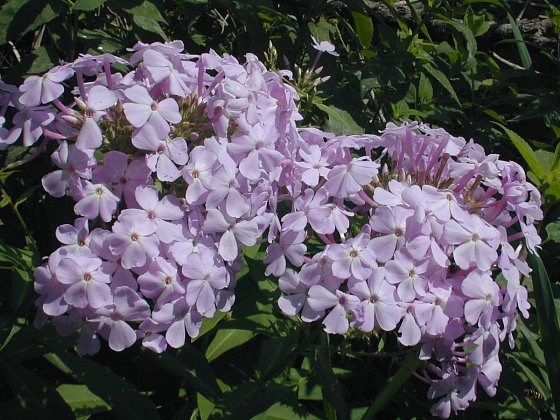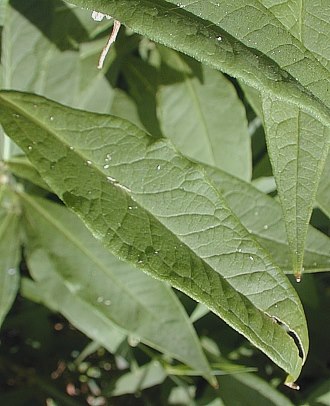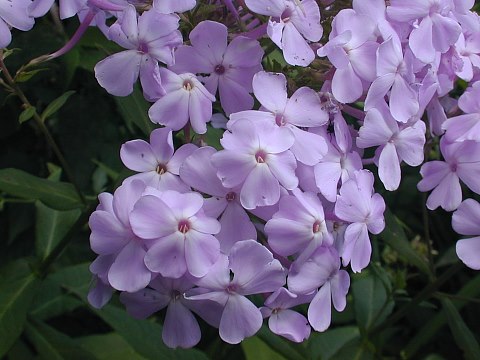Description: This herbaceous perennial plant is 2-4' tall and usually unbranched, except near the apex where the flowers occur. The central stem is light green, round, and usually hairless. Sometimes fine purple streaks occur along the stem. The opposite leaves are up to 6" long and 1" across. They are narrowly ovate or ovate-oblong, with smooth margins and conspicuous pinnate and secondary venation. The margins are slightly ciliate, otherwise the leaves are hairless. The lower leaves have short petioles, while some of the upper leaves may be sessile and rounded at the base.

The central stem
and a few secondary stems near the apex of the plant terminate in
rather flat-headed or gently rounded panicles of flowers. These
flowering stems (peduncles) are often finely pubescent. The individual
flowers are about 1" long and ½–¾" across, and can occur in a variety
of colors, including bright rosy pink, lavender, and white. Each flower
has a long tubular corolla with 5 spreading petals that are
well-rounded and overlap slightly. The tubular calyx is green
(sometimes with purplish tints) and much smaller than the corolla. The
teeth of this calyx are long and narrow. Sometimes the calyx is
pubescent or hairy. The blooming period occurs from mid- to late summer
and lasts about 1½ months. The flowers are quite fragrant. The small
seed capsules have 3-cells and are oval in shape. Each cell usually
contains 2 small seeds. The root system consists of a taproot. Small
clumps of plants are often formed.
Cultivation:
The preference is partial sun, moist conditions, and fertile loamy
soil. Light shade is tolerated, but flowers will be produced less
abundantly. In full sun, the leaves have a tendency to turn yellowish
green and the plants are in greater danger of drying out. Sometimes the
leaves are attacked by various kinds of foliar disease, such as powdery
mildew. This appears to occur less often among plants growing in the
wild than among the cultivated strains that are typically grown in
flower gardens.

Range &
Habitat:
The native Summer Phlox has been observed in most counties of Illinois,
except in
the NW where it is often absent (see Distribution
Map). While this plant is widely distributed here and there,
it is rather uncommon in natural habitats, occurring as isolated clumps
of plants. Some populations are undoubtedly derived from cultivated
forms of the plant that have escaped. Habitats include openings in
moist to mesic woodlands, woodland borders, thickets, and semi-shaded
areas along rivers. Because of the attractive flowers, Summer Phlox is
quite common in flower gardens.
Faunal Associations:
The nectar of the flowers attracts butterflies, skippers, and moths,
including Hummingbird moths and Sphinx moths. Other insects don't have
long enough mouthparts to extract the nectar from the base of the
corolla. Small flower flies may feed on the pollen, but are not
effective pollinators. Some insects suck juices from Phlox spp.,
including Lopidea davisi (Phlox Scarlet Plant Bug)
and Poecilocapsus lineatus (Four-Lined Plant Bug),
while the adults of Epicauta pensylvanica (Black
Blister Beetle) eat the flowers or foliage. The caterpillars of some
moth species feed on the foliage or flowers as well, including Lacinipolia
olivacea (Olive Arches) and Heliothis phloxiphagus
(Spotted Straw). Mammalian herbivores occasionally eat the foliage of
this and other Phlox spp., including deer, rabbits, and livestock.

Photographic
Location:
A moist woodland edge at Meadowbrook Park in Urbana, Illinois.
Comments:
Summer Phlox is the largest of the Phlox spp. in
Illinois. This plant is easy to identify because of its leaves, which
have conspicuous secondary veins on their upper surface. In other Phlox
spp., only the central vein is prominent. A mature specimen
of Summer Phlox will have some leaves that easily exceed ½" in width,
while the leaves of other Phlox spp. are less than
½" in width. Summer Phlox usually blooms later than other species in
this genus, although its blooming period may overlap with Phlox
glaberrima (Smooth Phlox) to a limited extent. Another common
name for Phlox paniculata is Garden Phlox.